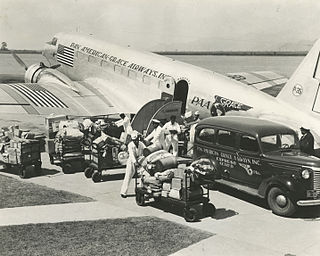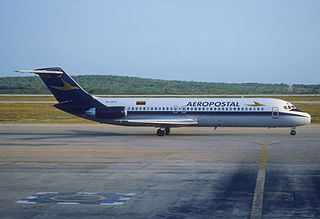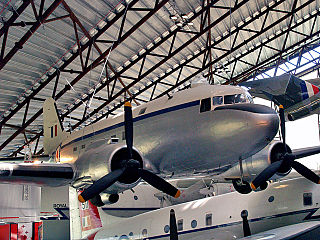
Lloyd Aéreo Boliviano S.A.M., was the flag carrier and principal airline of Bolivia from 1925 until it ceased operations in 2010. Before its demise it was headquartered in Cochabamba and had its main hubs at Jorge Wilstermann International Airport and Viru Viru International Airport. Founded in September 1925, it was the second oldest airline in South America after Avianca and one of the oldest airlines in the world.

On 2 August 1947, Star Dust, a British South American Airways (BSAA) Avro Lancastrian airliner on a flight from Buenos Aires, Argentina, to Santiago, Chile, crashed into Mount Tupungato, in the Argentine Andes. An extensive search operation failed to locate the wreckage, despite covering the area of the crash site, and the fate of the aircraft and its occupants remained unknown for over 50 years, giving rise to various conspiracy theories about its disappearance.
LATAM Airlines is an airline based in Santiago, Chile, and is one of the founders of LATAM Airlines Group, Latin America's largest airline holding company. The main hub is Comodoro Arturo Merino Benítez International Airport (Santiago), with secondary hubs in El Dorado (Bogotá), Jorge Chávez (Lima), Mariscal Sucre (Quito), and José Joaquín de Olmedo (Guayaquil) airports.
This is a list of aviation-related events from 1961:
This is a list of aviation-related events from 1977, This is the year of the second-deadliest air disaster in history, the Tenerife airport disaster. Here are the aviation events of 1977:

Pan American-Grace Airways, also known as Panagra, and dubbed "The World's Friendliest Airline" was an airline formed as a joint venture between Pan American World Airways and Grace Shipping Company. On September 13, 1928, a small single-engine Fairchild airliner flew from Lima, Peru, to Talara, Peru, which marked not only the beginning of Pan American Grace Airways but also the inauguration of scheduled air transportation along the West Coast of South America. From this short flight in 1928 to nonstop flights from New York to South America with Douglas DC-8 Intercontinental Jets in 1966, Panagra became the standard-bearer for transportation between the US Mainland East Coast and the West Coast of South America for 39 years. The "World's Friendliest Airline" merged with Braniff International Airways in 1967, and the combined carrier became the largest US airline serving South America.

On 27 June 1980, Itavia Flight 870, a McDonnell Douglas DC-9 passenger jet en route from Bologna to Palermo, Italy, crashed into the Tyrrhenian Sea between the islands of Ponza and Ustica, killing all 81 people on board. Known in Italy as the Ustica massacre, the disaster led to numerous investigations, legal actions and accusations, and continues to be a source of controversy, including claims of conspiracy by the Italian government and others. The Prime Minister of Italy at the time, Francesco Cossiga, attributed the crash to being accidentally shot down during a dogfight between Libyan and NATO fighter jets. A 1994 report argued the cause of the crash was a terrorist bomb, one in a years-long series of bombings in Italy. On 23 January 2013, Italy's top criminal court ruled that there was "abundantly" clear evidence that the flight was brought down by a missile, but the perpetrators are still missing.

On Friday, December 16, 1960, a United Airlines Douglas DC-8, bound for Idlewild Airport in New York City, collided in midair with a TWA Lockheed L-1049 Super Constellation descending into the city's LaGuardia Airport. The Constellation crashed on Miller Field in Staten Island and the DC-8 into Park Slope, Brooklyn, killing all 128 people on the two aircraft and six people on the ground. It was the deadliest aviation disaster in the world at the time. The death toll would not be surpassed until a Lockheed C-130B Hercules was shot down in May 1968, killing 155 people. In terms of commercial aviation, the death toll would not be surpassed until the March 1969 crash of Viasa Flight 742, which crashed on takeoff and killed all 84 people on board the aircraft, as well as 71 people on the ground. The accident became known as the Park Slope plane crash or the Miller Field crash, after the crash sites of each plane respectively. The accident was also the first hull loss and first fatal accident involving a Douglas DC-8.

United Airlines Flight 409 was a scheduled flight which originated in New York, New York. The final flight destination was San Francisco, California, with stops in Chicago, Denver and Salt Lake City. The aircraft operating the service, a Douglas DC-4 propliner, registration N30062, crashed into Medicine Bow Peak, near Laramie, Wyoming, on October 6, 1955, killing all 66 people on board. The victims included five female members of the Mormon Tabernacle Choir and military personnel. At the time, this was the deadliest airline crash in the history of American commercial aviation. Another 66 lives had been lost earlier that year in the March 22 crash in Hawaii of a United States Navy Douglas R6D-1 Liftmaster military transport aircraft, and 66 had also died in the mid-air collision of two United States Air Force C-119G Flying Boxcars over West Germany on August 11, placing the three crashes in a three-way tie as the deadliest aviation incidents in 1955.

On March 31, 1931, a Fokker F-10 belonging to Transcontinental and Western Air crashed near Bazaar, Kansas after taking off from Kansas City Municipal Airport, Kansas City, Missouri.

Aero Flight 311 (AY311), often referred to as the Kvevlax air disaster, was a scheduled domestic passenger flight operated by Aero O/Y between Kronoby, Finland and Vaasa. The aircraft, a Douglas DC-3, crashed in the municipality Kvevlax, nowadays part of Korsholm on 3 January 1961, killing all twenty-five people on board. The disaster remains the deadliest civilian aviation accident in the history of Finland. The investigation revealed that both pilots were intoxicated and should not have been flying.

West Coast Airlines Flight 956 was a scheduled commercial flight in the western United States which crashed on October 1, 1966, approximately 5.5 miles (9 km) south of Wemme, Oregon, southeast of Portland. Thirteen passengers and five crew members were aboard, but none survived. In its first week of service, the aircraft was destroyed by the impact and subsequent fire.

Green Cross is a defunct Chilean sports club that was based in the city of Santiago until 1965, when it moved to Temuco.

LAN Chile Flight 107 was a regular scheduled international flight from the Chilean capital Santiago to Buenos Aires in Argentina. On 6 February 1965, the Douglas DC-6B-404 operating the flight crashed in the Andes. All 87 occupants of the aircraft died in the crash.

Aeropostal Alas de Venezuela Flight 108 was a short-haul flight from La Chinita International Airport in Maracaibo, Venezuela to Santa Barbara Ed-L Delicias Airport that crashed on March 5, 1991.

The 1961 Derby Aviation crash refers to the fatal crash of a Douglas Dakota IV, registration G-AMSW, operated by Derby Aviation, the forerunner of British Midland Airways, on the mountain of Canigou, France, on 7 October 1961. All 34 on board were killed.

On January 31, 1957, a Douglas DC-7B operated by Douglas Aircraft Company was involved in a mid-air collision with a United States Air Force Northrop F-89 Scorpion and crashed into the schoolyard of Pacoima Junior High School located in Pacoima, a suburb in the San Fernando Valley of Los Angeles, California.














